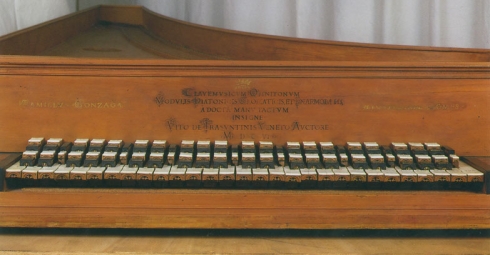The Archicembalo (Clavicymbalum Universale)
Music theoreticians as well as musicians were tormented by a (still) unsolved problem since ancient Greek authors like Pythagoras were rediscovered: the pure intonation of intervals. How could an instrument made possible to produce different pitches for different notes like e flat and d sharp which should be different according to context (d sharp leading to e as compared to e flat as a perfect fourth to b flat).
The modern standard of „equal“ temperament, a compromise achieved after long centuries represents, however, the least satisfying of all solutions by tuning all intervalls (except the octave) equally false to disperse the flaw of the pythagorean comma equally over all intervals. The only advantage of this form of temperament is the unlimited possibility of modulation and a freedom of selecting keys. The price are several particularly impure intervals like thirds and sixths, especially the major third which is about a sixth of a semitone sharp.
But the equal temperament has its technical and practical merits, visible when compared to a type of instrument described as "archicembalo" (by Nicola Vicentino) or "Clavicymbalum universale" or "Instrumentum perfectum" (by Michael Praetorius) or simply "Cimbalo cromatico" (by several italian contemporary composers).
On first sight the keyboard of this instrument built by Vito de
Trasuntino in Venice in 1606 following Nicola
Vicentino's treatise L'antica musica ridotta alla moderna prattica (Roma 1560), and today in Bologna, Museo di Musica, reveals a compass of four octaves with 31 keys per octave, 125 keys in all (a modern concert grand "only“ 88)! Instead of only one "black" upper key there are four, plus two more between the semitones e-f and b-c. Every common upper key is split in separate keys for every single sharp/flat and double sharp/flat note, adding e sharp and f flat between e and f and b sharp and c flat between b and c. Trasuntino added a specially calibrated monochord for exact tuning of those pitches.
| d double flat | d double sharp | g double flat | a double flat | adouble sharp | ||||||||||
| c double sharp | e double flat | f double sharp | g double sharp | b double flat | ||||||||||
| d flat | d sharp | f flat | g flat | a flat | a sharp | c flat | ||||||||
| c sharp | e flat | e sharp | f sharp | g sharp | b flat | b sharp | ||||||||
| c | d | e | f | g | a | b | (c) |

Other archicembalos like the instrument of Carl Luython. director of the Imerial court chapel in Prague known to Praetorius had „only“ 19 keys per octave, so no double sharps or flats and only one key between e-f and b-c
There are indeed a few compositions requiring instruments like these as well as some vocal compositions with similar chromaticisms for singers who however only needed well trained ears - like madrigals by Nicola Vicentino or Luzzascho Luzzaschi who also acquired fame as a player of an instrument of that kind.
For without any doubt the requirements for players as well as for tuners were terrific and did not popularise this "nearly ideal" solution for pure temperament in music.
The idea of split keys should, however, remain popular for providing at least a few alternatives for semitones (most usual for d sharp/e flat), or to add semitones to a "short octave" in the bass.
© Greifenberger Institut für Musikinstrumentenkunde | info@greifenberger-institut.de




